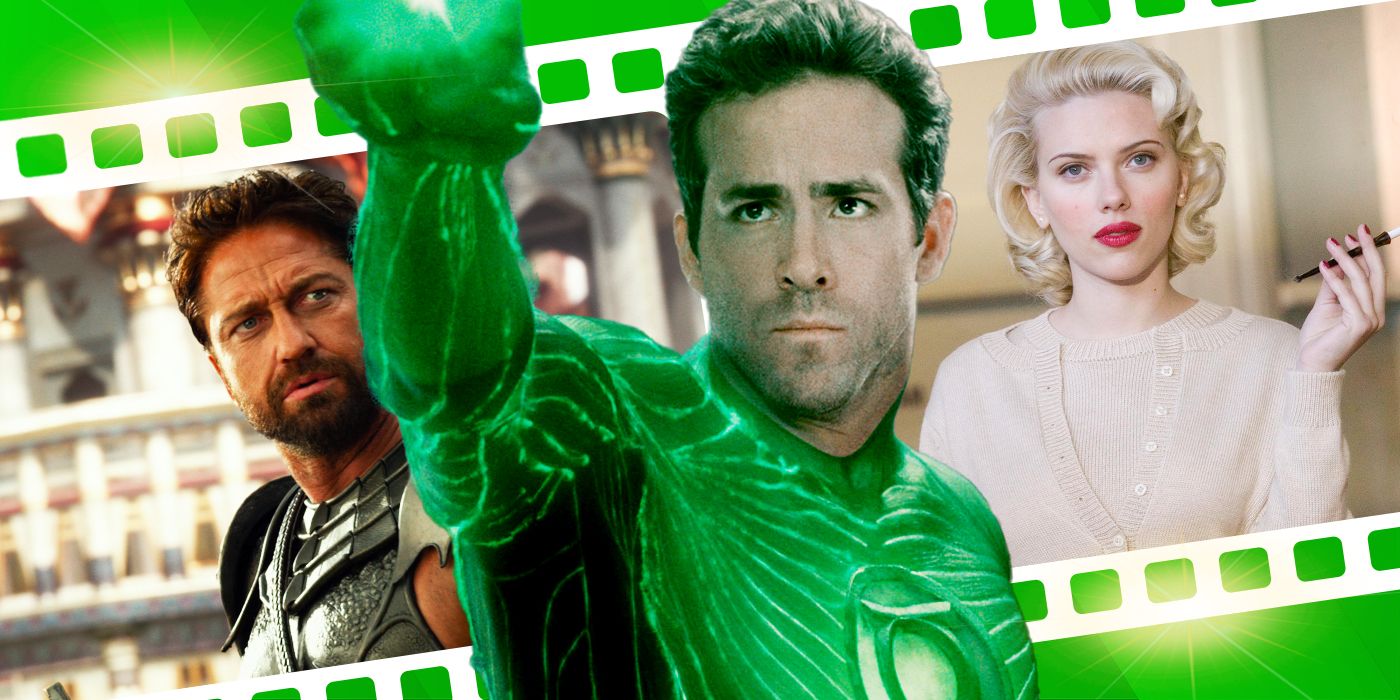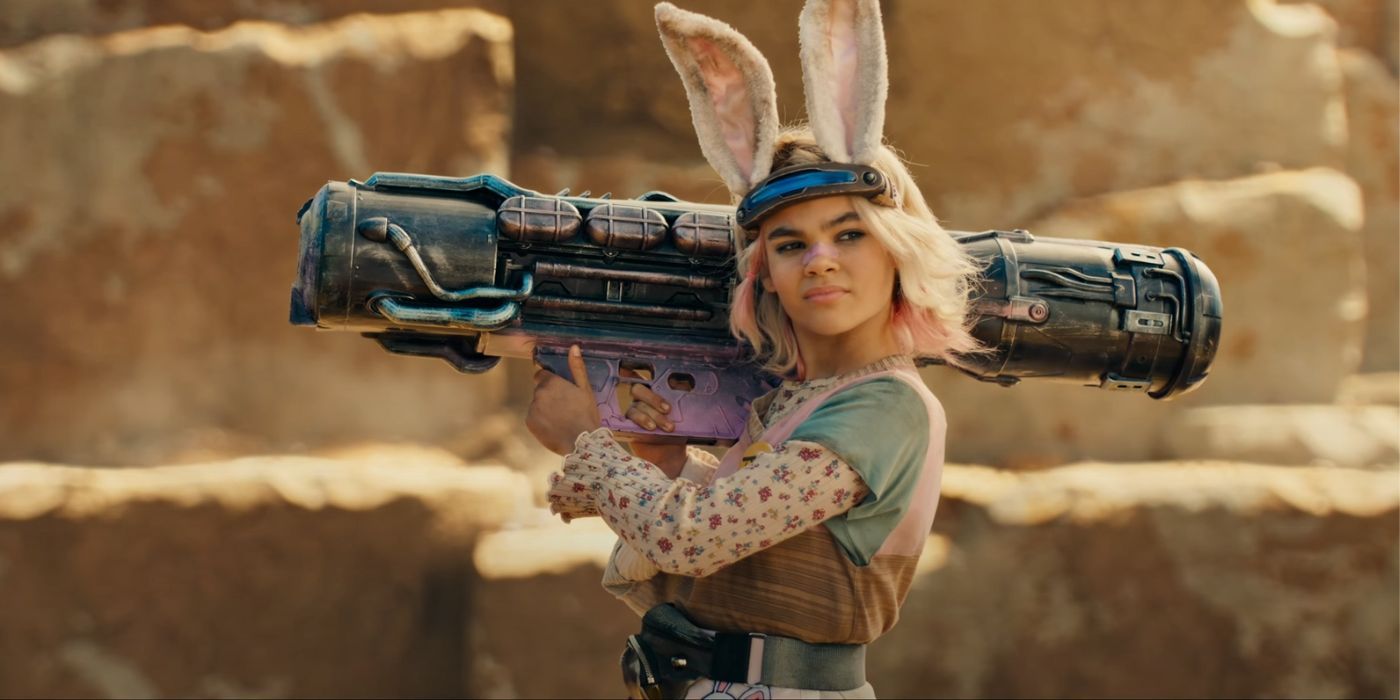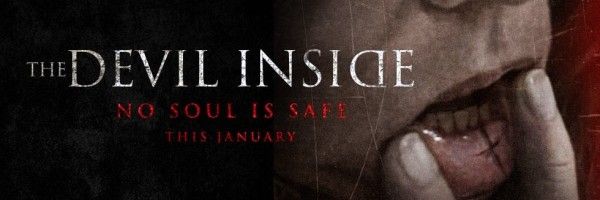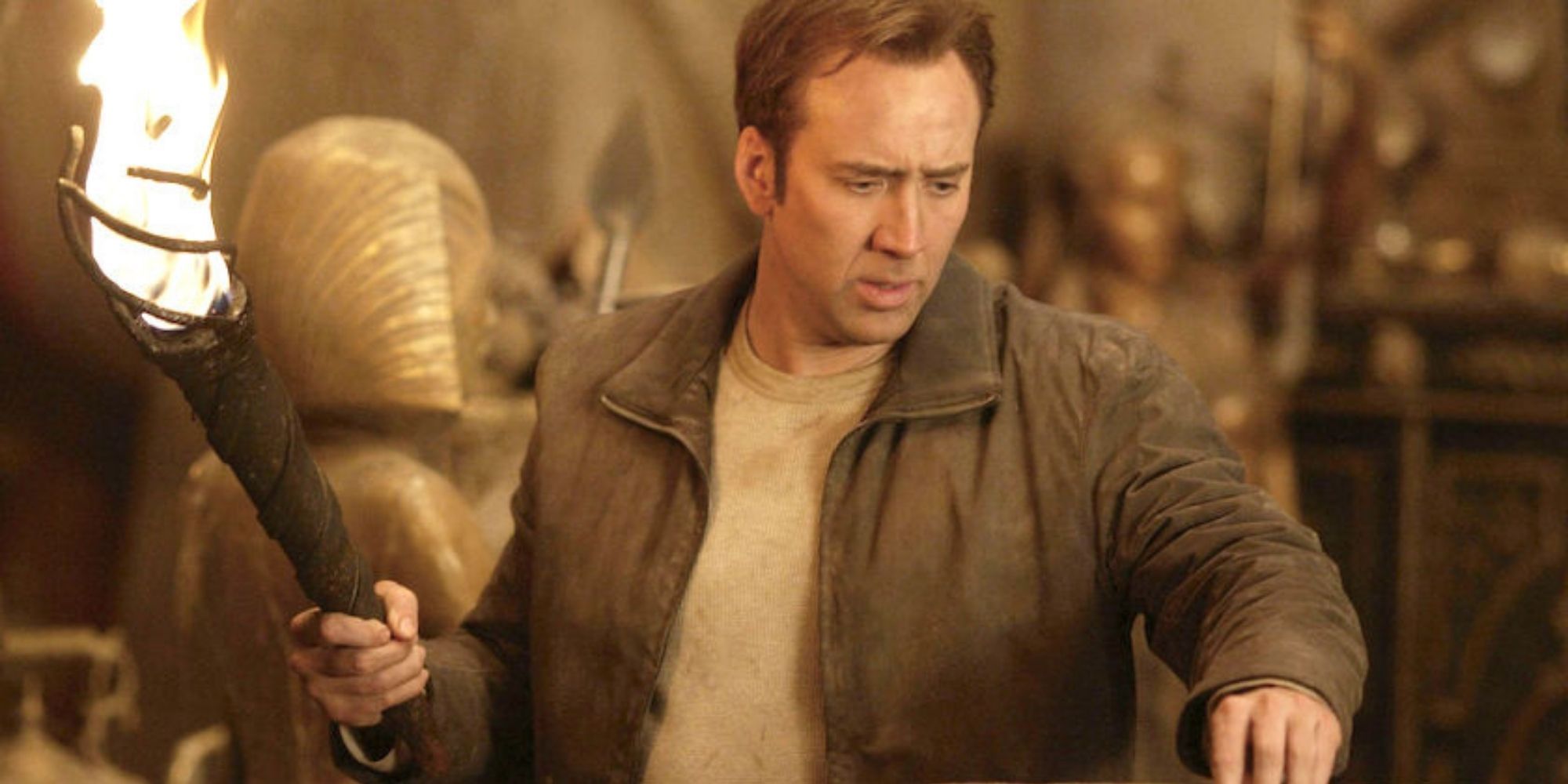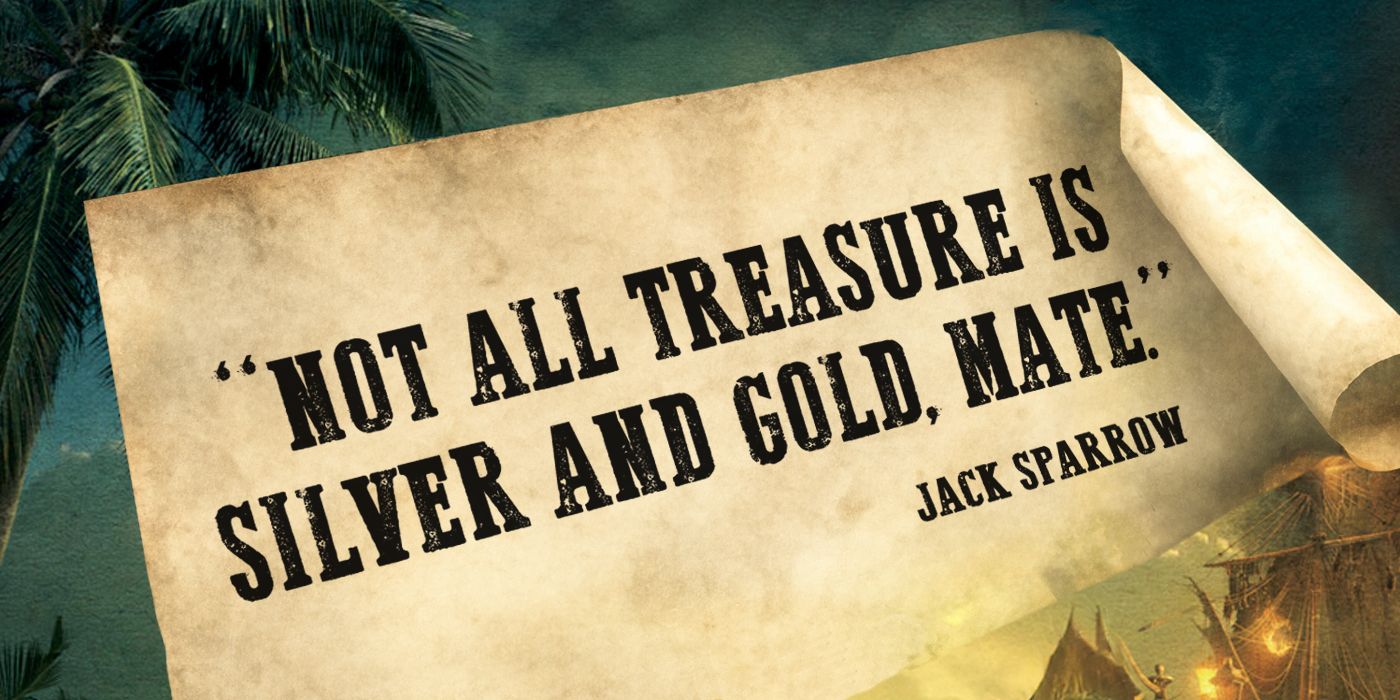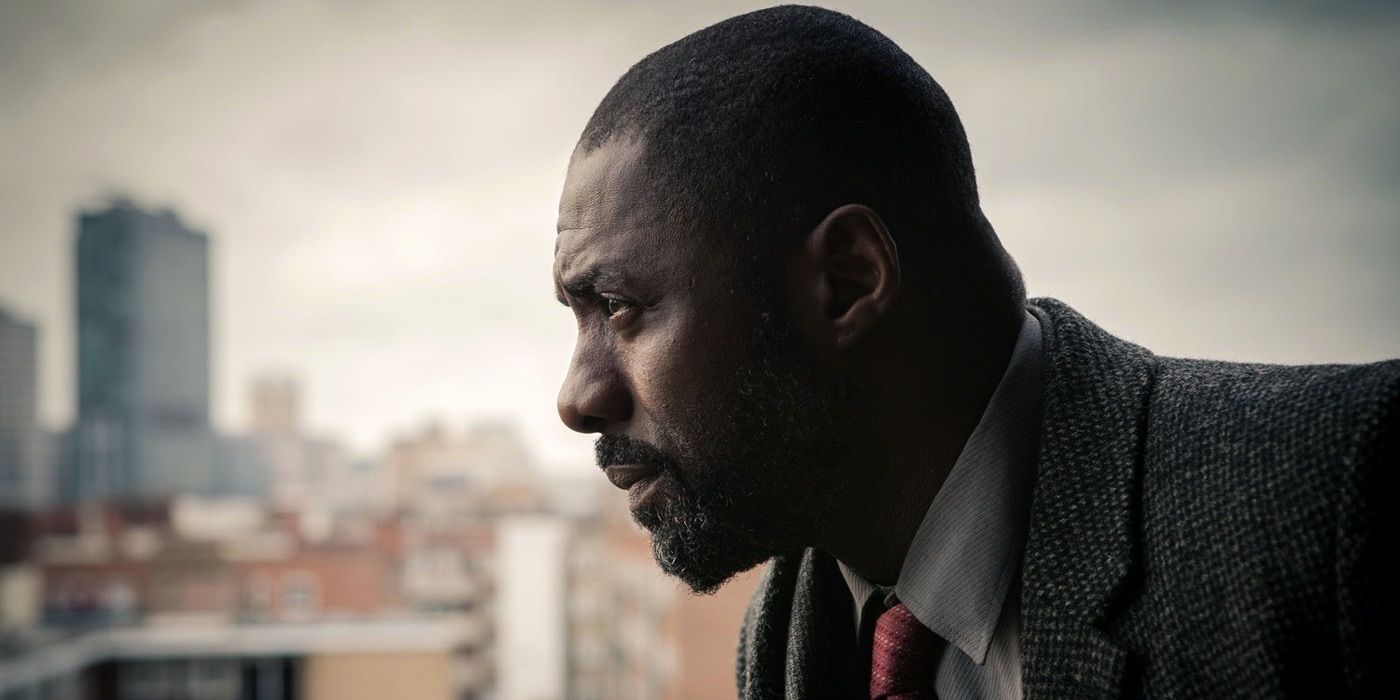This has got to be a strange weekend for the makers of The Devil Inside. The film is posed to far exceed box office prognostications grossing upward 30 million its first weekend. To put things into perspective: the film reportedly cost only a mil to make (though that’s not counting print and marketing – which puts the cost around 15 or so mil; but still it’s obviously a HUGE financial success for Paramount.) However – no one* really likes the movie. In fact most seem to downright hate it (an “F†Cinemascore, audiences across the country booing the ending, more Twitter-related hate than ever seemed possible within 140 characters…). I can’t quite remember the last time one movie created such a universal sense of vitriol.So the chance to speak with the creative team behind the smash-hit-but-universally-loathed (has there ever been a movie this disliked but also posed to make 4x its budget back?) was too good an opportunity to pass up. In the following interview with writer/director William Brent Bell, co-writer Matthew Peterman and producer Morris Paulson – the trio speak out about the glut of found footage films, backlash from the church and the most controversial ending to a film this year (also – the only ending yet to a film this year). For the full interview, hit the jump.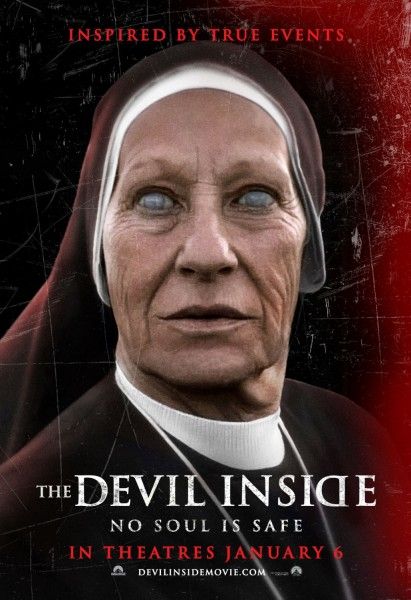 NOTE: the following interview was conducted via phone and at points in the conversation (i.e. my recording of) it was hard to make out what was being said or which of the three was saying it. I’ve done my best to transcribe the interview in the most accurate and detailed manner possible…How did you three get together to make films?MORRIS PAULSON: Matt and I have been friends for I don’t know how many years – maybe over a decade and that was sort of the origin of it - our friendship. It wasn’t until we actually got engaged in this process that we started making movies together. Brent and Matt have been making films and writing screenplays for quite some time. How long have you guys been doing this?MATTHEW PETERMAN: For about as long…The film has one of my favorite title card disclaimers – The Vatican does not approve this film --- Is that an actual point of contention? Is that there to set a mood for the film or for actual legal purposes?WILLIAM BRENT BELL: When we were shooting the film and researching and trying to interview people, we put feelers out to the Catholic Church to have discussions with them about the film. We sent them the script and things like that but they didn’t really want to have anything to do with the movie and of course we relayed that to our studio and there you have it…How do you research a film about exorcisms? What sort of process did you guys go through?PETERMAN: Well – a lot of books and a lot of interviews…
NOTE: the following interview was conducted via phone and at points in the conversation (i.e. my recording of) it was hard to make out what was being said or which of the three was saying it. I’ve done my best to transcribe the interview in the most accurate and detailed manner possible…How did you three get together to make films?MORRIS PAULSON: Matt and I have been friends for I don’t know how many years – maybe over a decade and that was sort of the origin of it - our friendship. It wasn’t until we actually got engaged in this process that we started making movies together. Brent and Matt have been making films and writing screenplays for quite some time. How long have you guys been doing this?MATTHEW PETERMAN: For about as long…The film has one of my favorite title card disclaimers – The Vatican does not approve this film --- Is that an actual point of contention? Is that there to set a mood for the film or for actual legal purposes?WILLIAM BRENT BELL: When we were shooting the film and researching and trying to interview people, we put feelers out to the Catholic Church to have discussions with them about the film. We sent them the script and things like that but they didn’t really want to have anything to do with the movie and of course we relayed that to our studio and there you have it…How do you research a film about exorcisms? What sort of process did you guys go through?PETERMAN: Well – a lot of books and a lot of interviews… 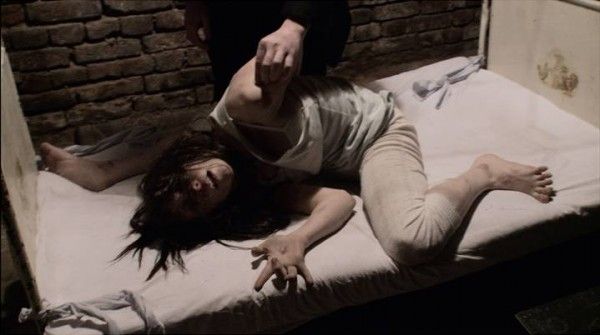 There has certainly been a glut of found footage horror films as of late. What was it about this template that made you want to use it for The Devil Inside?BELL: We started brainstorming this idea with each other two and a half years ago. The Blair Witch had come out. It was really Blair Witch – that and Cloverfield that piqued our interest in the genre. At the time, [found footage] hadn’t been used for [an exorcism film]. I thought it might be a good time to try it again. See what happens.PETERMAN: We wanted to add to the grammar of that genre. What sets us out from normal found footage films is that we set out to make a [faux] documentary as opposed to just found amateur footage. [The template] was a polished documentary. And as it continues on, it spirals out of control – so it becomes more “real-time†as opposed to just found footage.BELL: We also incorporated a lot of real footage into the film. We have interviews with real people, who are not actors like the neurologist and things like that. So we try to do this mix of fact and fiction to make people think that what they’re actually watching is real.
There has certainly been a glut of found footage horror films as of late. What was it about this template that made you want to use it for The Devil Inside?BELL: We started brainstorming this idea with each other two and a half years ago. The Blair Witch had come out. It was really Blair Witch – that and Cloverfield that piqued our interest in the genre. At the time, [found footage] hadn’t been used for [an exorcism film]. I thought it might be a good time to try it again. See what happens.PETERMAN: We wanted to add to the grammar of that genre. What sets us out from normal found footage films is that we set out to make a [faux] documentary as opposed to just found amateur footage. [The template] was a polished documentary. And as it continues on, it spirals out of control – so it becomes more “real-time†as opposed to just found footage.BELL: We also incorporated a lot of real footage into the film. We have interviews with real people, who are not actors like the neurologist and things like that. So we try to do this mix of fact and fiction to make people think that what they’re actually watching is real. 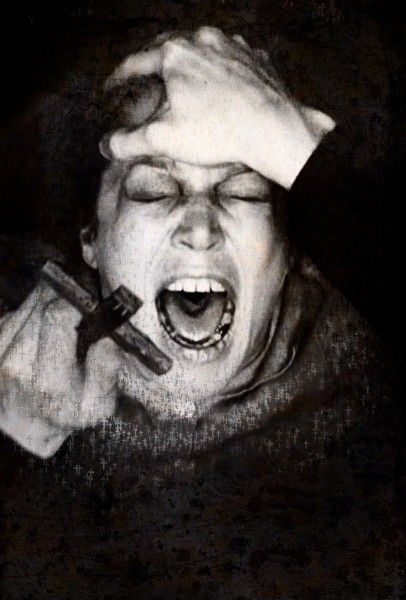 The abrupt ending certainly seems like a point of contention among many viewers. What was the intent to end the film on such an abrupt and bleak note?BELL: I think first of all – since we did the film outside the Hollywood system, we had the opportunity to take bigger chances. Originally there was more that happened but we decided let’s just do something a little more bold. Then we played around with other endings – but we just kept coming back to that and I think it’s kind of like the non-Hollywood ending. You don’t have a lot of opportunities to do that. We continue some of the stories online from that point in a different way, which is unique. We definitely embraced the idea and Paramount embraced the idea – something more shocking.PETERMAN: I also think it’s more realistic. Sometimes life doesn’t break down into a perfect three-act structure. We were just trying to shed a light on a specific period of time when something horrible happened in the lives of these characters. Sometimes real life doesn’t have the same kind of development in story that movies fabricate. And so we actually thought this would feel a little more real. Not the Hollywood experience.PAULSON: Not every story has a happy ending. We don’t always ride off into the sunset. Sometimes the devil wins.That’s also an unanswered mystery of the film. At the end you hint – that the demon’s - actually “The Devilâ€. Was that your intention?BELL: Yeah sure we do hint strongly at the end of the film that it is the main dude, if you will – but there’s also the concept that this demon has all these disciples. So it’s maybe more of his minions– but there’s certainly the hint that it could actually be the devil.
The abrupt ending certainly seems like a point of contention among many viewers. What was the intent to end the film on such an abrupt and bleak note?BELL: I think first of all – since we did the film outside the Hollywood system, we had the opportunity to take bigger chances. Originally there was more that happened but we decided let’s just do something a little more bold. Then we played around with other endings – but we just kept coming back to that and I think it’s kind of like the non-Hollywood ending. You don’t have a lot of opportunities to do that. We continue some of the stories online from that point in a different way, which is unique. We definitely embraced the idea and Paramount embraced the idea – something more shocking.PETERMAN: I also think it’s more realistic. Sometimes life doesn’t break down into a perfect three-act structure. We were just trying to shed a light on a specific period of time when something horrible happened in the lives of these characters. Sometimes real life doesn’t have the same kind of development in story that movies fabricate. And so we actually thought this would feel a little more real. Not the Hollywood experience.PAULSON: Not every story has a happy ending. We don’t always ride off into the sunset. Sometimes the devil wins.That’s also an unanswered mystery of the film. At the end you hint – that the demon’s - actually “The Devilâ€. Was that your intention?BELL: Yeah sure we do hint strongly at the end of the film that it is the main dude, if you will – but there’s also the concept that this demon has all these disciples. So it’s maybe more of his minions– but there’s certainly the hint that it could actually be the devil. 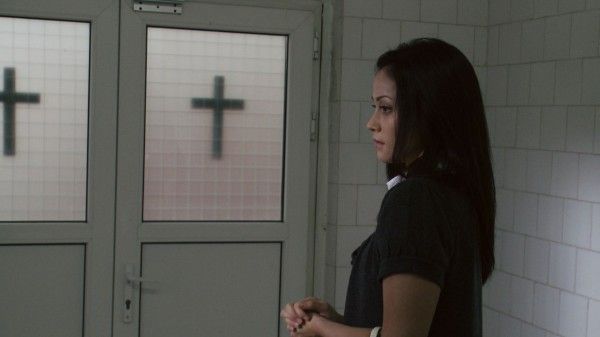 Will and Matt – you both wrote the film together. I’m interested in how that process works – do you write together or interchange scenes or rewrite each other’s work…?PETERMAN: It’s all those things actually. We build [the script] from the ground up, trade scenes back and forth. Each of us going off on specific scenes – just trading it back and forth and making it better each time until we feel it’s ready to be shot. It’s a really collaborative back and forth. BELL: It’s also not the process where one guy’s on the computer, the other guy’s pacing behind him. It’s a little different than that. Looking at The Devil Inside and your last film Stay Alive – these are both high concept horror films; but your first picture (Sparkle and Charm) is a much more low key dramedy. What predicated this switch in your work to genre horror?BELL: When we did that indie-Sundance vibe, we had dreams of making movies like The Matrix or the great horror films like The Exorcist. And we’d go wow – it’s going to take a long time to get there. So we decided when we wrote our first script together, to try to make things people would want to see in theaters and not worry about cost. We really like high concept and that’s what we wrote and it worked out and it shows in the work because people bought it and they liked it and we kept on that front of doing what we liked and we like really high concept films with three-layered characters.
Will and Matt – you both wrote the film together. I’m interested in how that process works – do you write together or interchange scenes or rewrite each other’s work…?PETERMAN: It’s all those things actually. We build [the script] from the ground up, trade scenes back and forth. Each of us going off on specific scenes – just trading it back and forth and making it better each time until we feel it’s ready to be shot. It’s a really collaborative back and forth. BELL: It’s also not the process where one guy’s on the computer, the other guy’s pacing behind him. It’s a little different than that. Looking at The Devil Inside and your last film Stay Alive – these are both high concept horror films; but your first picture (Sparkle and Charm) is a much more low key dramedy. What predicated this switch in your work to genre horror?BELL: When we did that indie-Sundance vibe, we had dreams of making movies like The Matrix or the great horror films like The Exorcist. And we’d go wow – it’s going to take a long time to get there. So we decided when we wrote our first script together, to try to make things people would want to see in theaters and not worry about cost. We really like high concept and that’s what we wrote and it worked out and it shows in the work because people bought it and they liked it and we kept on that front of doing what we liked and we like really high concept films with three-layered characters. 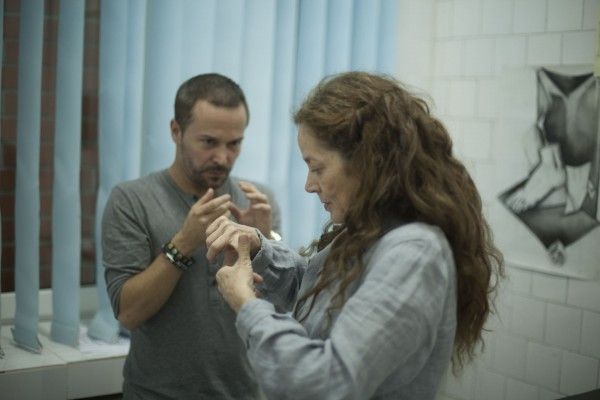 What sort of projects do you have in development now after The Devil Inside?BELL: We have some things in the similar vein as The Devil Inside – a couple are slightly more traditional but very intense thrillers. We don’t know exactly which one we’ll do first. We’ll probably know in the next two weeks.Is there any thought of continuing on with story of The Devil Inside – considering how things are left off at the end?BELL: If we feel like there’s room for another story, we’d love to -- but the movie should be definitely taken as a whole.*Contrarian footnote: I feel like I’m in the extreme minority that almost kind-of sorta liked The Devil Inside. Its got rogue exorcist priests cursing and stealing women from hospitals, my favorite opening title disclaimer card on a film in years, and unlike most found footage films where nothing happens for 75 minutes and then in the last 10 minutes witches (or trolls or a ghost or a person-standing-in-a-corner) show up, at least in The D.I., actual, you know, things occur – multiple exorcisms, possessions, crazy accents… Plus that ending: it’s good to know that in these somewhat troubled and divided times, all of America could come together on one issue.This has got to be a strange weekend for the makers of The Devil Inside. The film is posed to far exceed box office prognostications grossing upward 3 0 million its first weekend. To put things into perspective: the film reportedly cost only a mil to make (though that’s not counting print and marketing – which puts the cost around 15 or so mil; but still it’s obviously a HUGE financial success for Paramount.) However – no one* really likes the movie. In fact most seem to downright hate it (an “F†Cinemascore, audiences across the country booing the ending, more Twitter-related hate than ever seemed possible within 140 characters…). I can’t quite remember the last time one movie created such a universal sense of vitriol.So the chance to speak with the creative team behind the smash-hit-but-universally-loathed (has there ever been a movie this disliked but also posed to make 4x its budget back?) was too good an opportunity to pass up. In the following interview with writer/director William Brent Bell, co-writer Matthew Peterman and producer Morris Paulson – the trio speak out about the glut of found footage films, backlash from the church and the most controversial ending to a film this year (also – the only ending yet to a film this year). For the full interview, hit the jump.Of note: the following interview was conducted via phone and at points in the conversation (i.e. my recording of) it was hard to make out what was being said or which of the three was saying it. I’ve done my best to transcribe the interview in the most accurate and detailed manner possible…How did you three get together to make films?Morris Paulson: Matt and I have been friends for I don’t know how many years – maybe over a decade and that was sort of the origin of it - our friendship. It wasn’t until we actually got engaged in this process that we started making movies together. Brent and Matt have been making films and writing screenplays for quite some time. How long have you guys been doing this?Matthew Peterman: For about as long…The film has one of my favorite title card disclaimers – The Vatican does not approve this film --- Is that an actual point of contention? Is that there to set a mood for the film or for actual legal purposes?William Brent Bell: When we were shooting the film and researching and trying to interview people, we put feelers out to the Catholic Church to have discussions with them about the film. We sent them the script and things like that but they didn’t really want to have anything to do with the movie and of course we relayed that to our studio and there you have it…How do you research a film about exorcisms? What sort of process did you guys go through? Matthew Peterman: Well – a lot of books and a lot of interviews…There has certainly been a glut of found footage horror films as of late. What was it about this template that made you want to use it for The Devil Inside? William Brent Bell: We started brainstorming this idea with each other two and a half years ago. The Blair Witch had come out. It was really Blair Witch – that and Cloverfield that piqued our interest in the genre. At the time, [found footage] hadn’t been used for [an exorcism film]. I thought it might be a good time to try it again. See what happens.Matthew Peterman: We wanted to add to the grammar of that genre. What sets us out from normal found footage films is that we set out to make a [faux] documentary as opposed to just found amateur footage. [The template] was a polished documentary. And as it continues on, it spirals out of control – so it becomes more “real-time†as opposed to just found footage.William Brent Bell: We also incorporated a lot of real footage into the film. We have interviews with real people, who are not actors like the neurologist and things like that. So we try to do this mix of fact and fiction to make people think that what they’re actually watching is real.The abrupt ending certainly seems like a point of contention among many viewers. What was the intent to end the film on such an abrupt and bleak note?William Brent Bell: I think first of all – since we did the film outside the Hollywood system, we had the opportunity to take bigger chances. Originally there was more that happened but we decided let’s just do something a little more bold. Then we played around with other endings – but we just kept coming back to that and I think it’s kind of like the non-Hollywood ending. You don’t have a lot of opportunities to do that. We continue some of the stories online from that point in a different way, which is unique. We definitely embraced the idea and Paramount embraced the idea – something more shocking.Matthew Peterman: I also think it’s more realistic. Sometimes life doesn’t break down into a perfect three-act structure. We were just trying to shed a light on a specific period of time when something horrible happened in the lives of these characters. Sometimes real life doesn’t have the same kind of development in story that movies fabricate. And so we actually thought this would feel a little more real. Not the Hollywood experience.Morris Paulson: Not every story has a happy ending. We don’t always ride off into the sunset. Sometimes the devil wins.That’s also an unanswered mystery of the film. At the end you hint – that the demon’s - actually “The Devilâ€. Was that your intention?William Brent Bell: Yeah sure we do hint strongly at the end of the film that it is the main dude, if you will – but there’s also the concept that this demon has all these disciples. So it’s maybe more of his minions– but there’s certainly the hint that it could actually be the devil.Will and Matt – you both wrote the film together. I’m interested in how that process works – do you write together or interchange scenes or rewrite each other’s work…?Matthew Peterman: It’s all those things actually. We build [the script] from the ground up, trade scenes back and forth. Each of us going off on specific scenes – just trading it back and forth and making it better each time until we feel it’s ready to be shot. It’s a really collaborative back and forth. William Brent Bell: It’s also not the process where one guy’s on the computer, the other guy’s pacing behind him. It’s a little different than that. Looking at The Devil Inside and your last film Stay Alive – these are both high concept horror films; but your first picture (Sparkle and Charm) is a much more low key dramedy. What predicated this switch in your work to genre horror?William Brent Bell: When we did that indie-Sundance vibe, we had dreams of making movies like The Matrix or the great horror films like The Exorcist. And we’d go wow – it’s going to take a long time to get there. So we decided when we wrote our first script together, to try to make things people would want to see in theaters and not worry about cost. We really like high concept and that’s what we wrote and it worked out and it shows in the work because people bought it and they liked it and we kept on that front of doing what we liked and we like really high concept films with three-layered characters.What sort of projects do you have in development now after The Devil Inside?William Brent Bell: We have some things in the similar vein as The Devil Inside – a couple are slightly more traditional but very intense thrillers. We don’t know exactly which one we’ll do first. We’ll probably know in the next two weeks.Is there any thought of continuing on with story of The Devil Inside – considering how things are left off at the end?William Brent Bell: If we feel like there’s room for another story, we’d love to -- but the movie should be definitely taken as a whole.*Contrarian footnote: I feel like I’m in the extreme minority that almost kind-of sorta liked The Devil Inside. Its got rogue exorcist priests cursing and stealing women from hospitals, my favorite opening title disclaimer card on a film in years, and unlike most found footage films where nothing happens for 75 minutes and then in the last 10 minutes witches (or trolls or a ghost or a person-standing-in-a-corner) show up, at least in The D.I., actual, you know, things occur – multiple exorcisms, possessions, crazy accents… Plus that ending: it’s good to know that in these somewhat troubled and divided times, all of America could come together on one issue.
What sort of projects do you have in development now after The Devil Inside?BELL: We have some things in the similar vein as The Devil Inside – a couple are slightly more traditional but very intense thrillers. We don’t know exactly which one we’ll do first. We’ll probably know in the next two weeks.Is there any thought of continuing on with story of The Devil Inside – considering how things are left off at the end?BELL: If we feel like there’s room for another story, we’d love to -- but the movie should be definitely taken as a whole.*Contrarian footnote: I feel like I’m in the extreme minority that almost kind-of sorta liked The Devil Inside. Its got rogue exorcist priests cursing and stealing women from hospitals, my favorite opening title disclaimer card on a film in years, and unlike most found footage films where nothing happens for 75 minutes and then in the last 10 minutes witches (or trolls or a ghost or a person-standing-in-a-corner) show up, at least in The D.I., actual, you know, things occur – multiple exorcisms, possessions, crazy accents… Plus that ending: it’s good to know that in these somewhat troubled and divided times, all of America could come together on one issue.This has got to be a strange weekend for the makers of The Devil Inside. The film is posed to far exceed box office prognostications grossing upward 3 0 million its first weekend. To put things into perspective: the film reportedly cost only a mil to make (though that’s not counting print and marketing – which puts the cost around 15 or so mil; but still it’s obviously a HUGE financial success for Paramount.) However – no one* really likes the movie. In fact most seem to downright hate it (an “F†Cinemascore, audiences across the country booing the ending, more Twitter-related hate than ever seemed possible within 140 characters…). I can’t quite remember the last time one movie created such a universal sense of vitriol.So the chance to speak with the creative team behind the smash-hit-but-universally-loathed (has there ever been a movie this disliked but also posed to make 4x its budget back?) was too good an opportunity to pass up. In the following interview with writer/director William Brent Bell, co-writer Matthew Peterman and producer Morris Paulson – the trio speak out about the glut of found footage films, backlash from the church and the most controversial ending to a film this year (also – the only ending yet to a film this year). For the full interview, hit the jump.Of note: the following interview was conducted via phone and at points in the conversation (i.e. my recording of) it was hard to make out what was being said or which of the three was saying it. I’ve done my best to transcribe the interview in the most accurate and detailed manner possible…How did you three get together to make films?Morris Paulson: Matt and I have been friends for I don’t know how many years – maybe over a decade and that was sort of the origin of it - our friendship. It wasn’t until we actually got engaged in this process that we started making movies together. Brent and Matt have been making films and writing screenplays for quite some time. How long have you guys been doing this?Matthew Peterman: For about as long…The film has one of my favorite title card disclaimers – The Vatican does not approve this film --- Is that an actual point of contention? Is that there to set a mood for the film or for actual legal purposes?William Brent Bell: When we were shooting the film and researching and trying to interview people, we put feelers out to the Catholic Church to have discussions with them about the film. We sent them the script and things like that but they didn’t really want to have anything to do with the movie and of course we relayed that to our studio and there you have it…How do you research a film about exorcisms? What sort of process did you guys go through? Matthew Peterman: Well – a lot of books and a lot of interviews…There has certainly been a glut of found footage horror films as of late. What was it about this template that made you want to use it for The Devil Inside? William Brent Bell: We started brainstorming this idea with each other two and a half years ago. The Blair Witch had come out. It was really Blair Witch – that and Cloverfield that piqued our interest in the genre. At the time, [found footage] hadn’t been used for [an exorcism film]. I thought it might be a good time to try it again. See what happens.Matthew Peterman: We wanted to add to the grammar of that genre. What sets us out from normal found footage films is that we set out to make a [faux] documentary as opposed to just found amateur footage. [The template] was a polished documentary. And as it continues on, it spirals out of control – so it becomes more “real-time†as opposed to just found footage.William Brent Bell: We also incorporated a lot of real footage into the film. We have interviews with real people, who are not actors like the neurologist and things like that. So we try to do this mix of fact and fiction to make people think that what they’re actually watching is real.The abrupt ending certainly seems like a point of contention among many viewers. What was the intent to end the film on such an abrupt and bleak note?William Brent Bell: I think first of all – since we did the film outside the Hollywood system, we had the opportunity to take bigger chances. Originally there was more that happened but we decided let’s just do something a little more bold. Then we played around with other endings – but we just kept coming back to that and I think it’s kind of like the non-Hollywood ending. You don’t have a lot of opportunities to do that. We continue some of the stories online from that point in a different way, which is unique. We definitely embraced the idea and Paramount embraced the idea – something more shocking.Matthew Peterman: I also think it’s more realistic. Sometimes life doesn’t break down into a perfect three-act structure. We were just trying to shed a light on a specific period of time when something horrible happened in the lives of these characters. Sometimes real life doesn’t have the same kind of development in story that movies fabricate. And so we actually thought this would feel a little more real. Not the Hollywood experience.Morris Paulson: Not every story has a happy ending. We don’t always ride off into the sunset. Sometimes the devil wins.That’s also an unanswered mystery of the film. At the end you hint – that the demon’s - actually “The Devilâ€. Was that your intention?William Brent Bell: Yeah sure we do hint strongly at the end of the film that it is the main dude, if you will – but there’s also the concept that this demon has all these disciples. So it’s maybe more of his minions– but there’s certainly the hint that it could actually be the devil.Will and Matt – you both wrote the film together. I’m interested in how that process works – do you write together or interchange scenes or rewrite each other’s work…?Matthew Peterman: It’s all those things actually. We build [the script] from the ground up, trade scenes back and forth. Each of us going off on specific scenes – just trading it back and forth and making it better each time until we feel it’s ready to be shot. It’s a really collaborative back and forth. William Brent Bell: It’s also not the process where one guy’s on the computer, the other guy’s pacing behind him. It’s a little different than that. Looking at The Devil Inside and your last film Stay Alive – these are both high concept horror films; but your first picture (Sparkle and Charm) is a much more low key dramedy. What predicated this switch in your work to genre horror?William Brent Bell: When we did that indie-Sundance vibe, we had dreams of making movies like The Matrix or the great horror films like The Exorcist. And we’d go wow – it’s going to take a long time to get there. So we decided when we wrote our first script together, to try to make things people would want to see in theaters and not worry about cost. We really like high concept and that’s what we wrote and it worked out and it shows in the work because people bought it and they liked it and we kept on that front of doing what we liked and we like really high concept films with three-layered characters.What sort of projects do you have in development now after The Devil Inside?William Brent Bell: We have some things in the similar vein as The Devil Inside – a couple are slightly more traditional but very intense thrillers. We don’t know exactly which one we’ll do first. We’ll probably know in the next two weeks.Is there any thought of continuing on with story of The Devil Inside – considering how things are left off at the end?William Brent Bell: If we feel like there’s room for another story, we’d love to -- but the movie should be definitely taken as a whole.*Contrarian footnote: I feel like I’m in the extreme minority that almost kind-of sorta liked The Devil Inside. Its got rogue exorcist priests cursing and stealing women from hospitals, my favorite opening title disclaimer card on a film in years, and unlike most found footage films where nothing happens for 75 minutes and then in the last 10 minutes witches (or trolls or a ghost or a person-standing-in-a-corner) show up, at least in The D.I., actual, you know, things occur – multiple exorcisms, possessions, crazy accents… Plus that ending: it’s good to know that in these somewhat troubled and divided times, all of America could come together on one issue.


